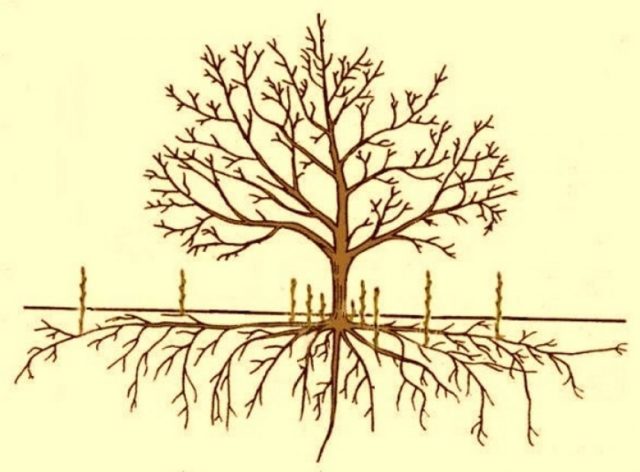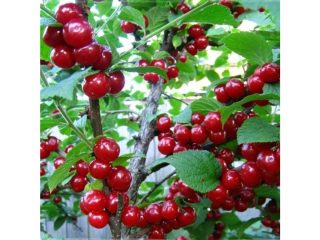Content
Many gardeners are faced with the problem of the formation of numerous root shoots in cherries. Often, even after uprooting a tree, young shoots stubbornly continue to make their way into the light, filling the space of the garden. Getting rid of cherry trees on your property is quite difficult; it will require time and effort.
Why do cherries grow shoots?
The source of the formation of root shoots in cherries are horizontal roots located close to the surface of the earth. The more of them a tree has, the more intensely new shoots form on them.

Cherry root growth reduces yield and interferes with work
There may be several reasons for the formation of a large number of root shoots. Here are the main ones.
- Features of the variety.
- Individual qualities of rootstock and scion.
- Incorrect landing. If the roots of the seedling were not properly buried when planting, they may begin to spread almost to the top.
- Heavy pruning.Incorrect or excessive shortening of shoots can give impetus to increased root growth.
- Damage to the root system, trunks or skeletal branches of the cherry.
- Incorrect watering.
- Poor compatibility of scion and rootstock.
Another reason for excessive growth of root shoots can be fallen berries. Cherry pits germinate well and can become the source of a large number of shoots.
How to deal with cherry growth
Root growth is a big problem for gardeners. Because of this, the cherry tree literally “spreads” across the site, making it difficult to excavate in the immediate vicinity of the tree. In addition, growing shoots take away a significant amount of strength and nutrients from the mother plant, and this negatively affects its productivity.

Scheme of the formation of root shoots quickly spreading throughout the area
Root growth can be fought in various ways, but this fight is not always successful. Often, after a short period of time after removal, the number of young shoots not only does not become smaller, but also increases many times over. The reason for this will be improper removal of the shoots. The peculiarity of the cherry is its vitality; the tree perceives any mechanical impact as a threat to its life and takes retaliatory measures, releasing many young shoots. This must be taken into account and when removing root shoots, try not to injure either the roots or the above-ground part of the plant.
How to remove cherry growth from a plot using chemicals
In order to remove cherry root growth from the site, you can use herbicides - the same substances and compositions as for destroying weeds.Among these drugs, glyphosate-based formulations are the most widely used. These include Roundup, Tornado, Hurricane.
These drugs do not act selectively on vegetation. If you spray the root zone with herbicides, both the weeds and the young cherry shoots die.

Herbicides destroy not only cherry shoots, but also other plants
Many gardeners have a negative attitude towards the use of herbicides in the garden, rightly believing that the penetration of the active substance into the tissue of the tree can have negative consequences for it. In this case, there is only one way to remove cherry root growth - mechanically.
How to uproot cherry trees on your property with your own hands
If the cherry is old, dried out or affected by disease, then you need to get rid of it. Cutting down the ground part of the tree will not be difficult; this can be easily done with a hacksaw or chainsaw. Much more problems for the gardener are caused by cleaning the stump from the area. If it is not completely uprooted, the root growth will continue to bother the gardener even after the tree is removed. The branched root system will continue to intensively absorb nutrients from the soil, however, due to the absence of an above-ground part, the plant is forced to spend them on the formation of new shoots. The stumps must be uprooted, if possible, removing all remaining cherry roots from the ground.

The easiest way to uproot a stump is with an excavator or other heavy equipment.
The simplest way to uproot a cherry tree stump on your property is mechanical. In this case, it is simply torn out of the ground using powerful equipment, for example, an excavator.If access to the site for heavy vehicles is not possible, then you will have to work with hand tools. The stump is dug up from all sides, exposing the horizontal surface roots as far as possible. They are completely torn out of the ground, all the rest, going deeper, are cut with an ax. After this, the hole is covered with earth.
If time permits, a large stump can also be removed chemically. On the cut, it is necessary to drill as many deep holes as possible with a diameter of 8-12 mm, which are filled with table salt or ammonium nitrate and then covered with wax or paraffin. In 1-1.5 years, the salts will completely destroy the structure of the tree and the stump will dry out. After this, you can uproot such a cherry without much effort. When using ammonium nitrate, the dried stump is set on fire. Wood impregnated with ammonium nitrate smolders perfectly, and in a short time the stump completely burns out along with the roots and shoots.

You can also destroy a stump using chemical methods.
A video on how to destroy the stump of a cherry tree or any other tree without uprooting or cutting it down can be viewed at the link:
How to remove cherry blossoms using folk remedies
The only folk remedies that are effective against cherry blossoms are a shovel and a hoe. If a tree regularly forms numerous root shoots, then it is better to remove such cherries from the garden forever and replace the variety with another. A good option to limit the spread of horizontal roots is to dig sheets of slate around the cherry tree trunk at a distance of 0.7-0.75 m. In this case, the shoots will grow only inside this trunk circle.Regular pruning at a height of 0.25-0.3 m gradually reduces the number of sprouts, but it may take years to completely “wean” the cherry from throwing out new root shoots.

Regular pruning of the growth gradually reduces its number
It has been noticed that any damage to the roots of the cherry tree provokes rapid growth of root shoots. Therefore, as a preventive measure, it is recommended not to carry out excavation work in the root zone of the tree. During the summer heat, it is advisable to cover the tree trunk circle with spruce branches or straw. This will avoid cracking of the soil, which can cause damage to the root system. It has been noticed that frequent watering also provokes the growth of root shoots. Therefore, cherries should be watered rarely, but abundantly.
It is believed that the best way to remove cherry growth is to dig it up to the root and carefully trim it, then cover the cut with garden varnish. However, such a procedure is extremely labor-intensive. Therefore, many gardeners, trying to get rid of cherry bushes, simply mow down the young growth at ground level with a trimmer or lawn mower. This work should not be postponed until the end of the season; all shoots must be removed green before they become lignified. This will be more difficult to do later.

Mowing with a trimmer is a quick and effective way to get rid of root growth
When working with a trimmer when mowing the root zone, you must take precautions. Small debris, flying pieces of earth, pebbles and pieces of wood can seriously injure a tree trunk and damage the bark on it.To prevent this from happening, you need to put a plastic bottle cut lengthwise with the neck and bottom cut off onto the stem. If damage does occur, then the entire wound must be covered with garden varnish.
Which cherry does not sprout
Not all types of cherries are prone to forming root shoots. Varieties such as Bagryannaya, Vladimirskaya, Lyubskaya, Shalunya almost do not produce basal shoots, while Robin, Youth, Vole, Generous or Rastorguevka form them very intensively.
If the cherry is grafted, then its ability to shoot is determined not by the variety, but by the characteristics of the rootstock. Seed rootstocks almost do not form root shoots, as well as some clonal ones (Izmailovsky, AVCh-2). But self-rooted species are most prone to the formation of root shoots, since this is their natural method of reproduction. Moreover, young shoots begin to appear even in young plants.
Caring for the tree after removing the shoots
No special measures are usually taken after removing the root shoots. This procedure does not cause any damage to the cherry trees, but only if the roots are not damaged. If the shoots were cut directly at the root, then in this place the tears must be covered with garden varnish. Otherwise, infection or fungal spores may get into the wound.

All cuts must be covered with garden varnish.
If the tree trunk has been cleared of young growth, then it is also advisable to treat all cuts with garden varnish.
Preventing the appearance of overgrowth on the site
It is unlikely that it will be possible to permanently remove cherry root growth from a plot, but it is quite possible to reduce its amount to a minimum. Here's what experienced gardeners recommend doing for this.
- Do not plant varieties prone to root growth. Select seedlings grafted onto seed rootstocks.
- Avoid carrying out any work with the soil in the root zone of the cherry tree. You should not plant anything directly in the tree trunk circle.
- Do not allow the soil to dry out in the root zone. Water rarely, but abundantly, and then mulch the tree trunk circle.
- Cut off emerging growth immediately, before it becomes woody.
- Avoid mechanical damage to the cherry tree trunk and its roots.
- Pruning, especially radical pruning, should not be done at once, but over several years.
- Limit the spread of horizontal roots by digging sheets of slate or other dense material (metal, plastic) around the cherry tree to a depth of at least 0.5 m.
- The root zone can be covered with a layer of roofing material or other dense material, for example, old linoleum. Nothing will grow under it, including root shoots.
- Remove fallen berries.
- Take measures to prevent the occurrence of diseases and pests.

The better the cherry care, the less root growth there will be.
Strictly speaking, any measures aimed at maintaining the health of cherries will prevent the appearance of root shoots. Timely fertilizing and watering, caring for the tree trunk, treatment against diseases and pests, competent timely pruning and whitewashing of trunks - all this contributes to the good condition of the trees and does not provoke them to grow new root shoots.That is why you need to take care of the health of the cherries and carry out all work to care for the plantings on time and in full.
Conclusion
Probably every gardener dreams of completely getting rid of cherry trees on his plot, but not everyone succeeds. The main assistant in this matter is undoubtedly patience. Even a badly neglected cherry orchard can be brought back to life, but this will require time and a lot of work. And to avoid such a situation, it is necessary to choose the right varieties and regularly care for cherries, starting from the moment the seedling is planted.








